Repair of the water supply system is a real test for all residents. It is almost impossible to replace pipes in an apartment in one day on your own. It will take at least two or three days to cut off the old plumbing and replace the sewer. Only then can you assemble a new wiring in the apartment.
If we take into account that any plumber from the housing office works only until lunch, then the time allotted for preparing to replace pipes can double.
The content of the article:
-
How to replace plumbing pipes
- Preparation for repair
- Completion of preparation
- Types of piping
- When is pipe replacement necessary and at whose expense is it performed?
-
What material to choose so that the replacement of pipes is successful
- Metal-plastic pipes
- Polypropylene pipes
- Copper pipes
- Pipes made of galvanized steel
-
How to replace pipes with your own hands
- Replacement of water pipes
- Replacement of sewer pipes
- Replacement of heating pipes
- Replacement of fan pipes
- How much does it cost to replace pipes
How to replace plumbing pipes
The first thing to do is assess your capabilities. Replacement can start with a lengthy paperwork that most tenants don't have time for. The second problem is related to the choice of contract scheme:
- You can conclude an agreement with a repair and construction organization.
- Hire a plumber who professionally replaces pipes in apartments or houses.
- Negotiate informally with locksmiths from the Housing Office.
- Do-it-yourself pipe replacement with your own hands.
Don't get hung up on one option. Most likely, in the course of repairing an apartment or simply replacing pipes, all available schemes will have to be used. For example, you have to negotiate with the mechanics of the housing office to turn off the water at the riser so that you can replace the inlet valve of the apartment.
At some stages of work, you will need to invite the master. He must make the most complex wiring elements, eliminate marriage or suggest how to do it right.
If you plan to install heating equipment or a gas column, a boiler, then you will need to look for a private enterprise with a license. Before negotiating with the master or the team, it is worth making inquiries about the quality of the work performed from other customers.
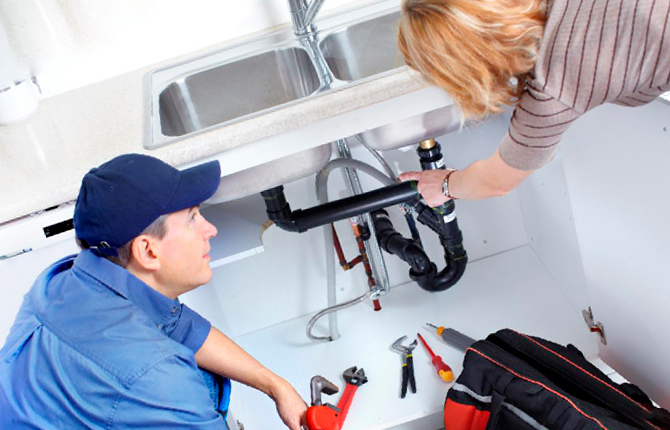
As a rule, there are no problems with the masters or locksmiths of the Housing Office. Like all plumbers, it is hard for them to make full contact, but after clarifying the scope of work and the level of payment, the situation is getting better.
With a private construction company, there may be problems of inadequate quality of work performed. Therefore, if there are no real levers of influence on the management of the company, all requirements must be spelled out in detail in the contract for the replacement of pipes in the apartment. At the same time prepare to personally control the stages of the project.
Preparation for repair
Usually, the decision to replace is made in a situation where the condition of water and sewer communications requires urgent intervention. It will be necessary to submit an application to the housing office to turn off the water on the riser and open the mine wall.
Usually locksmiths, for a small fee, turn off the water and dismantle the wall to gain access to the tee on the sewer riser. But at the same time they are always asked to apply for a job.
The next step is to contact the inspector of the Gorvodokanal and through him apply for a temporary removal of the seal from the water meter in the apartment. If you make a complete replacement, then the meter must be removed, there is a risk of damage to the seal, so it is better to play it safe.
As soon as the water is shut off, the well is opened through the wall of the apartment, you can replace the valve at the input. This must be done immediately to enable the residents of the remaining apartments of the entrance to use water.
Suggest to the housing office mechanics to replace the old inlet valve with a new one. A crane, winding and tools need to be bought or prepared in advance.
Usually plumbers willingly change the valve at the entrance to the apartment for a small surcharge. It is important that these works are performed by a housing office locksmith. The procedure for replacing a tap on an inlet pipe is risky even on a new riser. Without experience, you can easily break the inlet pipe. This is a job for professionals only.
If you are not lucky with the housing office fitters (the degree of adequacy can be assessed during the first communication), invite a master plumber from outside. In any case, it is necessary to replace the valve at the entrance to the apartment immediately and with the highest quality. The same applies to dismantling the adapter from the toilet to the tee of the sewer riser.
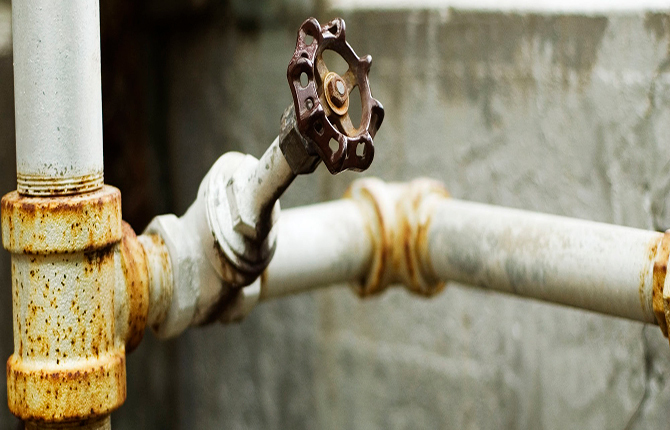
Completion of preparation
After replacing the input of the cold water pipe, they proceed to the revision of the sewer riser. You need to inspect and assess its condition.
If the sewer riser is rotten, there are traces of sewage flowing, then the housing office or the partnership will be forced to change it, moreover, quickly and at its own expense. This is an emergency situation - if communications are not replaced, then drains can flood apartments in the entrance of the house.
If the condition of the pipe is satisfactory (no rust, paint and caulking at the joints are preserved), then one of three solutions is possible:
- The vertical sewer shaft is inspected completely. In the absence of comments, they are left without replacement.
- In agreement with the owners of all apartments in the entrance, connected to one sewer pipe, the housing office performs a complete replacement of the sewer riser.
- If it is not possible to replace the entire barrel, only the damaged area is changed.
According to building codes, cast-iron risers in residential high-rise buildings must be replaced after 25 years of operation or in the event of a pipe breakage. But sometimes, for a number of reasons, a riser with tees, even after 40-50 years of operation, remains in good condition and can be used further. Experts advise - if the riser is not damaged, do not change high-quality cast iron for plastic sewage.
Risers made of PVC, polyisobutylene, polypropylene must be changed at the slightest damage to the pipe walls.
To complete the preparatory stage, you need to connect the toilet to the tee on the riser, make a temporary connection to the washbasin. It is important that during the period of pipe replacement in the apartment it is possible to use the bathroom and the bathroom.
Types of piping
Inside the apartment, the owners can lay pipes in any way. But they bear full responsibility for the re-equipment of communications or improper replacement in case of force majeure.
The only exception is the pipes and risers of the central heating system. They can be patched, replaced with blanks with the same flow area, both metal and plastic.
Forbidden in the apartment change risers and water flow diagram. For example, it is impossible to equip a warm floor in rooms with water channels connected to the riser of the central heating system.
Even if there is a heat meter at the entrance to the apartment. Any changes in the heating scheme may become the basis for a fine from the city heating network.
The apartments use three piping diagrams:
- tee - for cold / hot water, sewerage, heating;
- collector - for cold, sometimes for hot water;
- parallel-series - for heating large apartments.
The first option is the simplest - one common branch of the water pipe is laid from the riser, to which all consumers are connected through tees. In parallel with the water supply communications, a sewer drain pipe is laid.
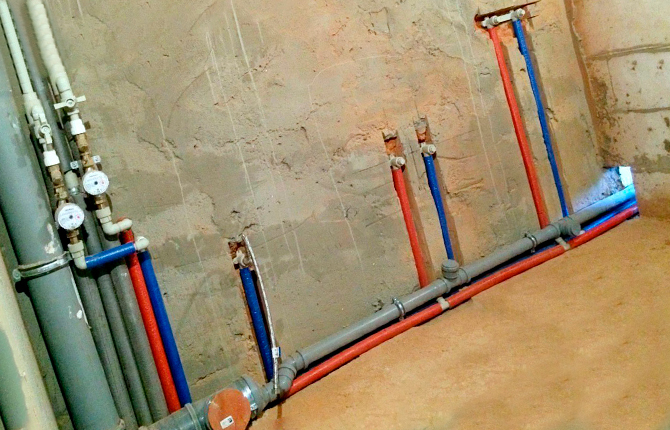
The collector scheme is used for apartments of complex layout. An inlet valve, a meter, a filter and a collector are connected to the riser, from which water pipes are routed. In this case, a separate branch of water and sewerage is laid for each consumer in the apartment.
The parallel-series circuit is used in apartments with a large living room or in studios.
When is pipe replacement necessary and at whose expense is it performed?
By law, water, heating and drain communications are completely subject to replacement during a major overhaul, and also partially in the event of an accident. The term is determined by the type of multi-storey building, heating system and water supply. The higher the load on the pipes, the shorter the overhaul period. But in this case we are talking about external communications. Everything inside the apartment is subject to replacement at the discretion of the owners of the property.
According to the legislation, a housing maintenance office or an association of tenants-owners of apartments in a building is obliged to service, repair, if necessary, replace the central water and sewer riser of the entrance with a pipe outlet to inlet valve. For sewerage - up to the tee of the common riser.
Therefore, if there is no debt for payment of housing and communal services to the Partnership or the Housing Office, you need to write an application addressed to the head demanding the replacement of specific pipes in the entrance.
The application must be:
- Written in a business style, legally literate, understandable language, with the correct use of technical terms and titles.
- Motivated. It is necessary to explain the approximate amount of work to replace and indicate the reasons why it needs to be done as a matter of urgency.
- A legal document containing all the details of the appeal, the correct name of the organization, the full name of the applicant.
The document must indicate the deadline for providing a response. The application is sent by mail, with a notification of delivery. No options with e-mail, leaving an appeal to the secretary or deputy head of the housing office.
At the request of citizens, a response must be sent within up to 2 weeks. Usually this is an unsubscribe with the assurance that the application has been accepted and will be included in the plan for the next year (half year). When it is planned to replace pipes in a particular house, only the chief engineer of the housing office, employees of the planning department and locksmiths know.

Therefore, before indulging in paperwork, it is worth talking with plumbers on this issue. If the replacement needs to be carried out on an emergency basis, then it makes sense to communicate with the management personally, to explain the situation.
Perhaps take the engineer (chief engineer) to the apartment, show the condition of the pipes at the input. In the budget of the ZhEK there is an article for financing emergency facilities, so there is a chance to replace pipes at the input at the expense of public funds.
Even if the management refused to replace the pipes for free, you should not indulge in correspondence, try to file claims and waste time. It is possible to force the Housing Office by a court decision to make a replacement - you need to submit an application. Otherwise, bureaucratic fuss will only become a useless waste of time and effort.
What material to choose so that the replacement of pipes is successful
The time when plumbing and heating systems were assembled from steel pipes by welding is finally gone. You can also find separate proposals for the assembly of water supply systems from stainless steel, anodized and galvanized pipes.
But to a greater extent, the replacement of apartment communications is performed with plastic or metal-plastic. Because assembly by soldering or fittings turns out to be simpler and more technologically advanced than welding.
Metal-plastic pipes
The technology for arranging a water supply system involves the assembly / joining of individual pipe blanks mechanically, using fittings. It is impossible to solder, weld, connect metal-plastic pipes to each other in any other way.
The fitting itself is a coupling that is put on the end of the pipe and crimped with special tongs. Consolidation is reached at the expense of a rubber cuff in a detail. There are several dozen models of fittings of various shapes and sizes - tees, couplings, elbows, adapters for pipes made of other materials.
It takes an average of 3-5 minutes to install a part with preparation, so the option of replacing an old steel water pipe with metal-plastic is considered the fastest and most technologically advanced. Connection reliability is high. If the fitting is correctly installed, then the aluminum layer is reliably isolated from water.
The service life depends on the quality of the material. Leading manufacturers of metal-plastic and fittings offer to replace even central heating pipes. In certificates, you can find a service life in an apartment of up to 25 years and even 50 years.
It is known from practice that metal-plastic communications on cold water serve up to 15 years. Already after 2-3 years of operation, drops may appear, you have to periodically crimp the sleeve with pliers. This must be taken into account if you plan a replacement with the laying of metal-plastic in a strobe for plastering.
It is better not to put metal-plastic pipes on heating or hot water - any sealing rubber bands quickly age under the influence of heat and moisture. If you make a replacement, then stable PP or metal.
The durability of a metal-plastic water pipe depends on two factors:
- The amount of sand or fine rust in the water. The suspension acts as an abrasive and quickly damages the inner layer of polyethylene. It is necessary to put a filter at the entrance to the apartment with the possibility of periodic washing or replacement.
- Correct design of the pipe bend. If you bend a little more along an arc of a smaller radius, then the polyethylene will peel off from the aluminum core, a fistula will form in this place already 4-5 months after replacement.
If you adhere to the assembly technology and do not save on fittings, a metal-plastic pipe can stand before replacement for at least 10-15 years.
Polypropylene pipes
The most popular and affordable. Pipe blanks 32x3 mm can be used to replace cold water supply. The same size, but reinforced with aluminum foil or glass fiber, is used for the heating circuit.
If the apartment installed geyser or an individual heating boiler, it is quite possible to save money - put not reinforced, but ordinary PP pipes under hot water. The material withstands heating up to 65 ℃ at pressures up to 3 bar. Despite the fact that in reality, water with a temperature of 50 ℃ is already perceived by the skin of the hand as unbearably hot.
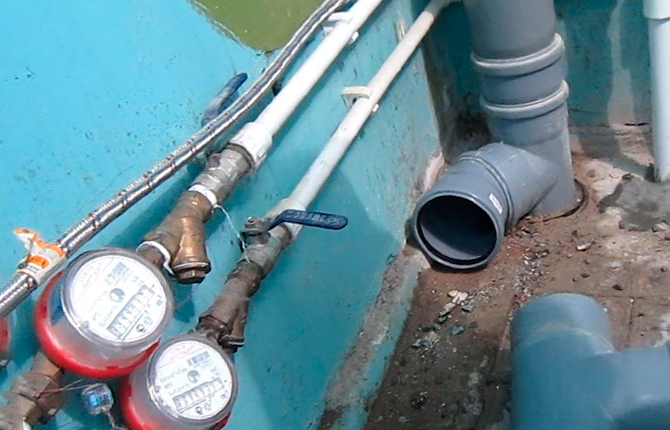
For apartment heating pipes, such experiments are not allowed. For replacement, you need to purchase fiberglass or reinforced with foil. More fiddling with PP-RCT/AL/PPR pipe, but it lasts longer.
Polypropylene is simply soldered. To master the process, it is enough to rent an electric soldering iron and make a few test joints on scraps of material. Polypropylene can be used to replace the central water riser, outlets, and any communications inside the apartment.
Pipe sections made of polypropylene, with a diameter of 50 mm and 100 mm, are almost always used to replace old cast iron sewer pipes. Sewerage is assembled from sections on rubber cuffs, without soldering.
The cast-iron sewer in the apartment should be disposed of as soon as possible. A pipe made of polypropylene is practically not subject to clogging, does not overgrow with fiber, any problems with fatty plugs are eliminated by rinsing with boiling water or just hot water and detergent.
Copper pipes
They are used only in the wiring of the heating circuit inside the apartment. It is impossible to use copper pipes to replace communications with drinking water according to sanitary and hygienic standards.
To replace hot water supply, copper is also not convenient. Due to the high coefficient of thermal conductivity, the copper pipe dissipates heat intensively. For heating an apartment, this does not really matter, and in the case of hot water supply, the water partially has time to cool down.
After replacement, copper communications have to be hidden in polypropylene foam covers. This is done for two reasons:
- To avoid heat losses on hot water supply communications.
- Limit air access to pipes with cold water, especially in the bathroom and bathroom. Otherwise, water condensate will regularly fall on the copper surface.
Often, copper pipes are specially used for wiring the heating circuit. For example, for the corner location of an apartment on the first floor of a building, dampness of “blind” walls is typical due to poor waterproofing and insufficient ventilation of the room.
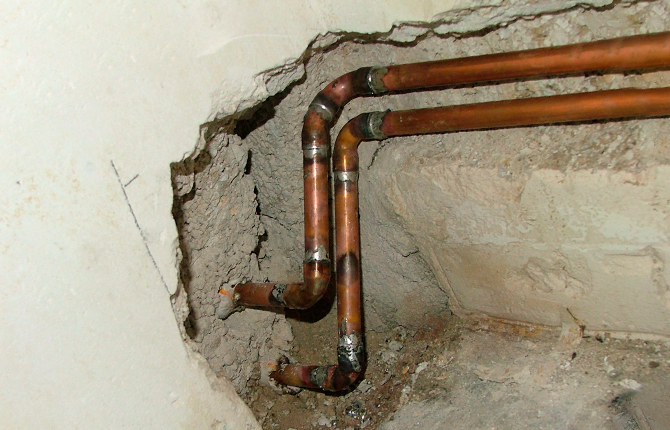
In this case, communications are laid along the wall at a small height above the floor. This is enough to fix the problem.
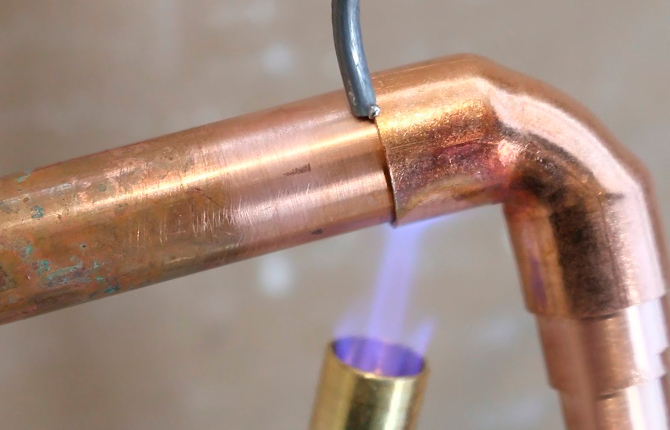
Copper communications are joined by soldering. The process is complex, you will need high-quality solder and a burner. The quality of the connection is high, and the seam is durable. You can make a connection on brass couplings, but in this case, the durability and quality of the joint will be at the level of metal-plastic.
The main advantage of using copper is its durability. If the replacement is done correctly and the copper communications are not allowed to come into contact with steel or aluminum fittings, then the pipes can last 50-70 years, depending on the soldering method.
Pipes made of galvanized steel
Before the advent of polypropylene and metal-plastic water pipes, pipe blanks with a protective coating based on zinc were considered the simplest and most reliable way to defeat the corrosion of steel communications.
Galvanized steel pipes were used for cold and hot water supply, for wiring heating systems.
The cost of blanks with a protective outer layer of zinc was not much more expensive than conventional mild steel, so the material was bought at every opportunity with the prospect of replacing all communications in the apartment at the first major repair.
Today, the popularity of galvanizing has decreased somewhat:
- high competition from metal-plastic and polypropylene;
- the flow area is overgrown with calcium and magnesium salts, rust in the same way as in ordinary steel pipes;
- low quality zinc layer;
- the complexity of assembling a galvanized water pipe.
Communications from galvanized pipes can be assembled on spurs, tees, corners, or conventional gas welding can be used. Therefore, to replace the old water supply, you will have to look for brass valves, galvanized spurs, couplings, nuts.
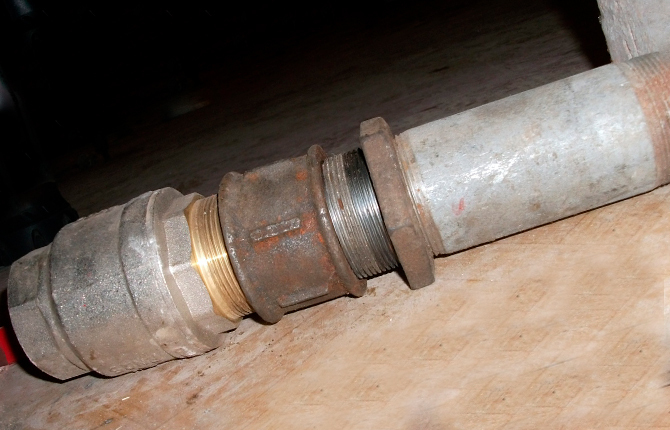
The best option is to order the manufacture of all parts in size, assemble the water supply on tee-pipes and, if possible, refuse to weld. Moreover, after that it will be necessary to protect the welding seam with galvanizing - the procedure is not the most pleasant. You can’t leave it - the welding site will begin to rust. It makes no sense to replace ordinary pipes with galvanized ones.
It is impossible to cook galvanized inside the apartment. When heated with a burner, zinc vapor sublimes. The welder, and at the same time the owners of the apartment, are seriously poisoned. Therefore, all preparation for replacing pipes, pre-assembly must be carried out outside the living quarters.
Inside the apartment, only simple assembly work is carried out. If you already had to weld galvanized pipes, then the zinc coating must be removed 2-3 cm from the edge, the rest should be wrapped with a wet rag.
To replace it, you will need to find argon or a semiautomatic device in advance. You cannot weld a high-quality seam with ordinary acetylene or electric welding.
If you manage to buy pipes with a high-quality zinc layer, then a new plumbing or heating system will last 20-25 years until the next replacement. It is better not to buy Chinese blanks with galvanization. They have a thin layer of zinc, porous, often you can even wipe it off with your fingers.
How to replace pipes with your own hands
If the preparation is successful, the water and sewer risers are in order, the bends have been replaced with valves for cold and hot water, then you can proceed to the assembly of water supply and heating systems apartments.
The first is to install and seal the hot and cold water meters. The sooner the controller of the Gorvodokanal seals up and gives permission for their work, the less they will have to pay for water supply. While metering devices are not installed in the apartment, the calculation for consumed water and drains is carried out according to the average consumption rate, which is almost two to three times more than according to the meter.

Replacement of water pipes
First you need to make marks on the walls - wherever you need to embed a tee for a flexible connection. Make the markup neatly and as accurately as possible. In this case, the rest of the pipe replacement comes down to cutting blanks and soldering (twisting fittings).
To replace, we cut off the old pipes with a grinder, remove them and clean out the traces of rust on the walls of the apartment.
From the meters we solder or assemble two horizontal pipes (hot and cold water) on the fittings. We do this to the nearest flexible connection point.
In this place, on each of the branches, we solder (screw) a tee coupling. A piece of pipe blank must be soldered into the central outlet to connect a flexible connection. We check the position according to the marks made earlier on the wall.
We fix horizontal pipes and vertical bends from tees to the wall using clamps. Thus, the position of the initial section of the water supply is rigidly fixed, which makes it possible to embed subsequent tees without fear of displacement (rotation) of already laid pipes. The replacement process can be continued without the risk of breaking the threaded connection on the water meter.
The only thing to pay attention to is the installation of branch pipes from the tees on the main line to the installation points of the bath faucet. In this case, it is necessary to prepare in advance two pipe sections with already soldered (screwed) fittings with threads for mixer adapters. On one make a bypass. Both segments are cut with a soldering allowance (mounting).
Each workpiece is soldered into the tee of the main pipe, strictly controlling the height of the installation, otherwise the mixer will stand obliquely after mounting on the thread.
Replacement of sewer pipes
Change the sewer You can before replacing the water supply or after, it does not really matter. But in some cases it is easier to start with sewer pipes, for example, if the toilet is directly connected through an adapter to a tee on the sewer riser.
In this case, the replacement will have to start with the sewer. There is no other way to get access to the riser.
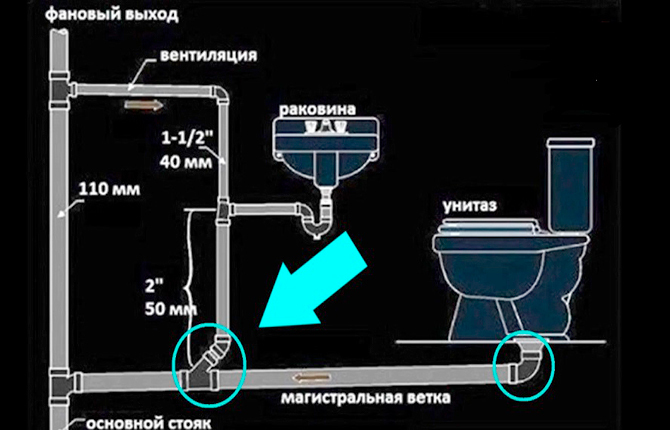
The most difficult stage is the dismantling of the cast-iron adapter (if the old pipes are made of cast iron) from the toilet to the riser. The compact itself is easy to remove, you just need to carefully clean the sealant between the faience pipe and the cast-iron socket. After dismantling the toilet, we close the hole with a cork made of tightly twisted and tied rags (so that the vacuum does not suck inside the riser).
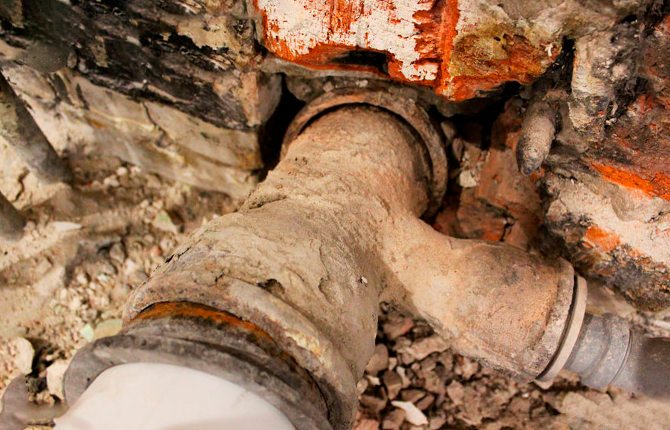
The first step is to beat the cement around the cast iron adapter so that you have access to the caulking of the joint between the socket of the tee on the riser and the end of the insert. Knock down gently, with light blows with a hammer and a steel screwdriver.
It will be more difficult to remove the mass of zachekank. It is carefully picked out with a screwdriver, without solvents or cleaners. The success of a sewer replacement often depends on the condition of the tee bowl on the riser. If you managed to pull out the cast-iron adapter and not split it, then further success is guaranteed.
Then clean the socket from the remnants of the sealing compound, insert a T-piece (one branch pipe per toilet, the second - to the main sewer line) and assemble a sewer pipe from pre-prepared sections.
Do not forget to insert tees for the washbasin, bathtub, sink, shower. Sewerage should be located with a slope of 5about. The end of the line is closed with a plug.
Replacement of heating pipes
Alteration of the heating circuit in the apartment is often complicated by the time of work. Replacement will have to be planned for the summer, when there is no water in the heating system. Usually it is July-August.
The replacement scheme depends on the type of pipe blanks. For example, if it is planned to replace the old wiring with galvanized pipes in an apartment, then the procedure will be as follows:
- For each section, cut out your workpiece with a thread allowance at the ends. The thread length is twice the diameter.
- For each workpiece, you will need a set of two threaded spigots with couplings and one fitting for connecting to a heating radiator.
- We cut off the old pipe at a distance of 250 mm from the heating riser. On the radiator, it must be unscrewed with a coccyx key.
- A pipe thread is cut on a piece welded to the riser. Usually this is an inch size.
- We screw a galvanized fitting into the radiator, screw the couplings onto the workpiece from the side of the riser and the radiator.
- We lay the winding on the fitting and the thread on the rest of the pipe from the side of the heating riser.
- We install a new pipe blank instead of the old one and unscrew the couplings for connection to the radiator and riser.
The process is laborious, it is difficult and physically difficult to cut a thread with a hand tool in an apartment. Therefore, from the side of the riser, it is possible to weld a threaded sleeve made of ordinary steel and wrap a pipe blank into it without a drive. Before that, you will have to prepare the apartment, free up space, remove flammable objects, open windows.
Replacing the pipe in the apartment can be done with polypropylene or metal-plastic. The scheme of work is similar to working with steel. Only instead of squeezing, soldering with couplings or assembly using fittings will be used.
But in any case, you will have to weld the adapter on the cut off end of the riser outlet. Next, a fitting made of metal-plastic or an adapter "fitting-polypropylene coupling" will be installed.
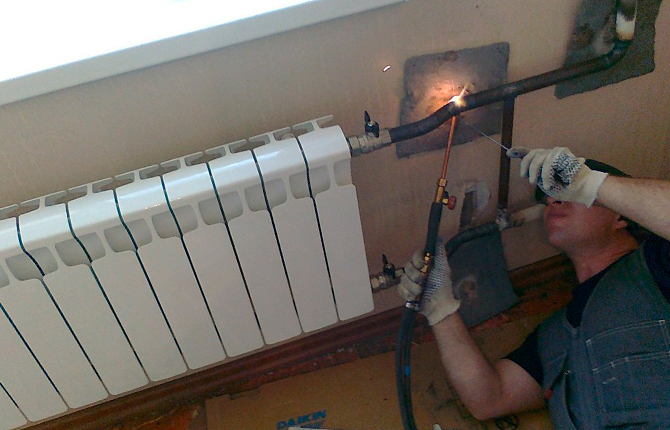
Replacement of fan pipes
The fan pipe is the upper part of the sewer riser, which is responsible for removing gases and equalizing the internal pressure at the time of discharge of wastewater through the pipe. If a large amount of water is drained, then all this mass acts like a piston.
A zone of low pressure is formed inside the sewer riser, if the vacuum is not compensated, then water will be sucked out of the toilet bowl. And in a few seconds, sewer gases will burst into the apartment. If something like this is observed, then you need to urgently apply to the Housing Office to replace the fan. Only plumbers should do the replacement.
The term fan over time "stuck" to the name of the sewer riser, it's more convenient and shorter. It is impossible to do the replacement of fan pipes with your own hands from the premises of the apartment.
To do this, at least open a few wells in the apartments. It is possible to remove the pipes from the mount only by a team of several people. This can be done by replacing the entire riser from cast iron to PVC pipes, or by making an insert.
In the latter case, locksmiths on the upper floors pull out adapters leading from the sewerage of the apartment to riser, hang the entire upper part of the pipe on cables and fix it to prevent involuntary lowering fan. Next, for replacement, the damaged section of the riser is cut out and thrown away, new sewer sections are installed.
The operation is risky, as there is a risk of destruction of the tees, but it has to be resorted to in situations where one of the apartment owners does not agree to replace the fan.
How much does it cost to replace pipes
The cheapest thing to do is to replace the sewer in an apartment from cast iron to plastic. Dismantling and installation costs from 600 rubles. for m.p. Insertion of additional tees from 800 rubles. for a point. Cleaning from 300 rubles. The most expensive replacement of the tee will cost - 1500-2000 rubles. subject to preparation.

The cost of replacing heating communications is calculated according to the prices for cold water pipes. Usually, the transition to new materials is made when installing individual heating boilers, so the cost of wiring the circuit is included in the overall estimate for the installation of equipment.
Replacing pipes in an apartment is a troublesome, time-consuming process that requires periodic consultations with specialists. The main problem is that each apartment has its own layout and piping. Therefore, it would be right to consult with the master - this will avoid difficulties in the process.
Tell us about your experience - what kind of pipes did you use to replace the old plumbing, heating and sewerage. What problems did you have to face? Save the material in your bookmarks so that you can re-read it at any time.


